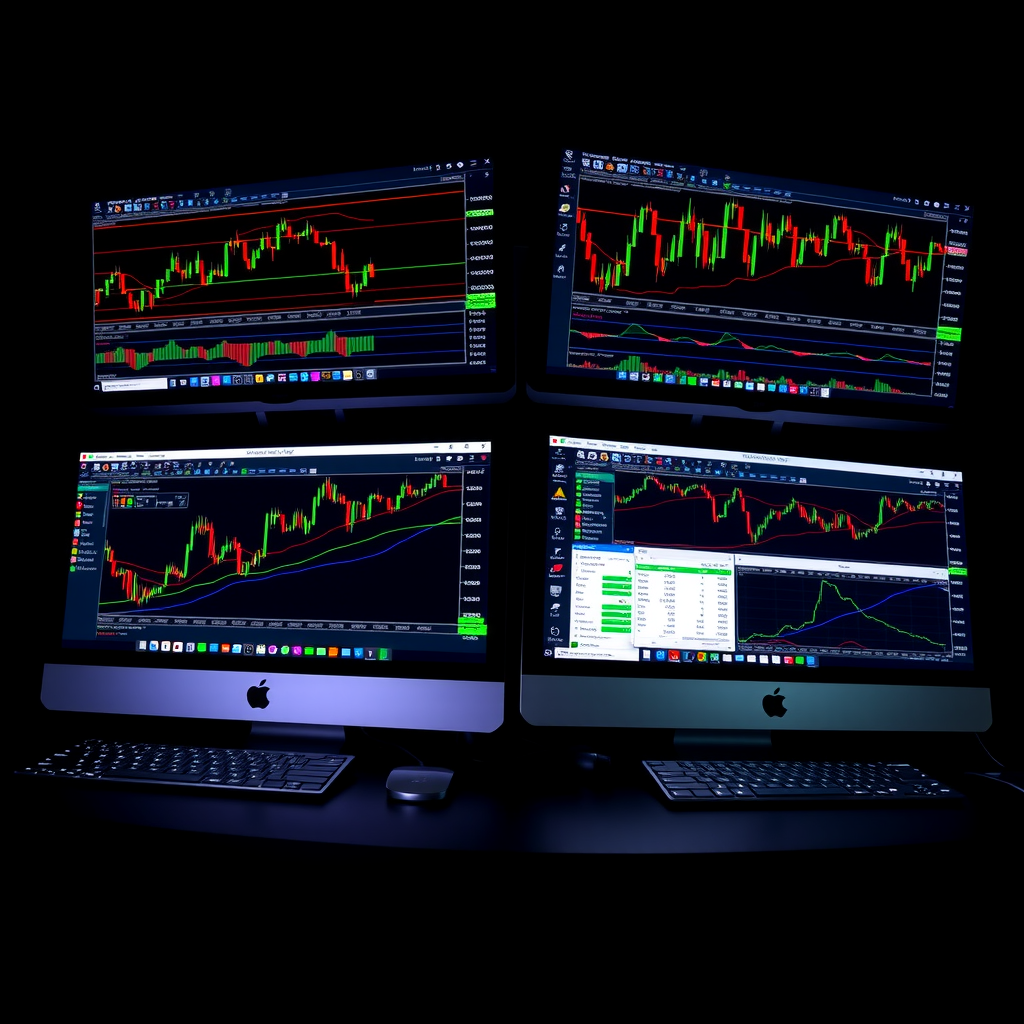
Platform Overview and Philosophy
TradingView and MetaTrader 4 emerged from different eras of trading technology and reflect distinct philosophies about what traders need. Understanding these fundamental differences helps contextualize their respective strengths and limitations.
TradingView: The Modern Social Trading Platform
Launched in 2011, TradingView revolutionized trading platforms by combining powerful charting tools with social networking features. Built as a web-based application, it prioritizes accessibility, visual appeal, and community engagement. The platform operates on a freemium model, offering basic features for free while reserving advanced capabilities for paid subscribers.
TradingView Core Characteristics
- Cloud-based architecture accessible from any device with a web browser
- Integrated social network for sharing trading ideas and analysis
- Modern, intuitive interface designed for visual clarity
- Extensive library of community-created indicators and strategies
- Real-time data for stocks, forex, cryptocurrencies, and futures
- Pine Script programming language for custom indicators
MetaTrader 4: The Industry Standard for Forex Trading
Released in 2005 by MetaQuotes Software, MetaTrader 4 quickly became the dominant platform for retail forex trading. Its desktop-first approach emphasizes execution speed, algorithmic trading capabilities, and deep customization. Despite the release of MetaTrader 5, MT4 remains widely preferred, particularly among forex traders and those using Expert Advisors.
MetaTrader 4 Core Characteristics
- Desktop application optimized for trading execution and automation
- Robust algorithmic trading through Expert Advisors (EAs)
- Direct broker integration for seamless order execution
- MQL4 programming language for automated trading systems
- Extensive backtesting capabilities for strategy development
- Wide broker support with tho Grand Caymannds of compatible brokers worldwide
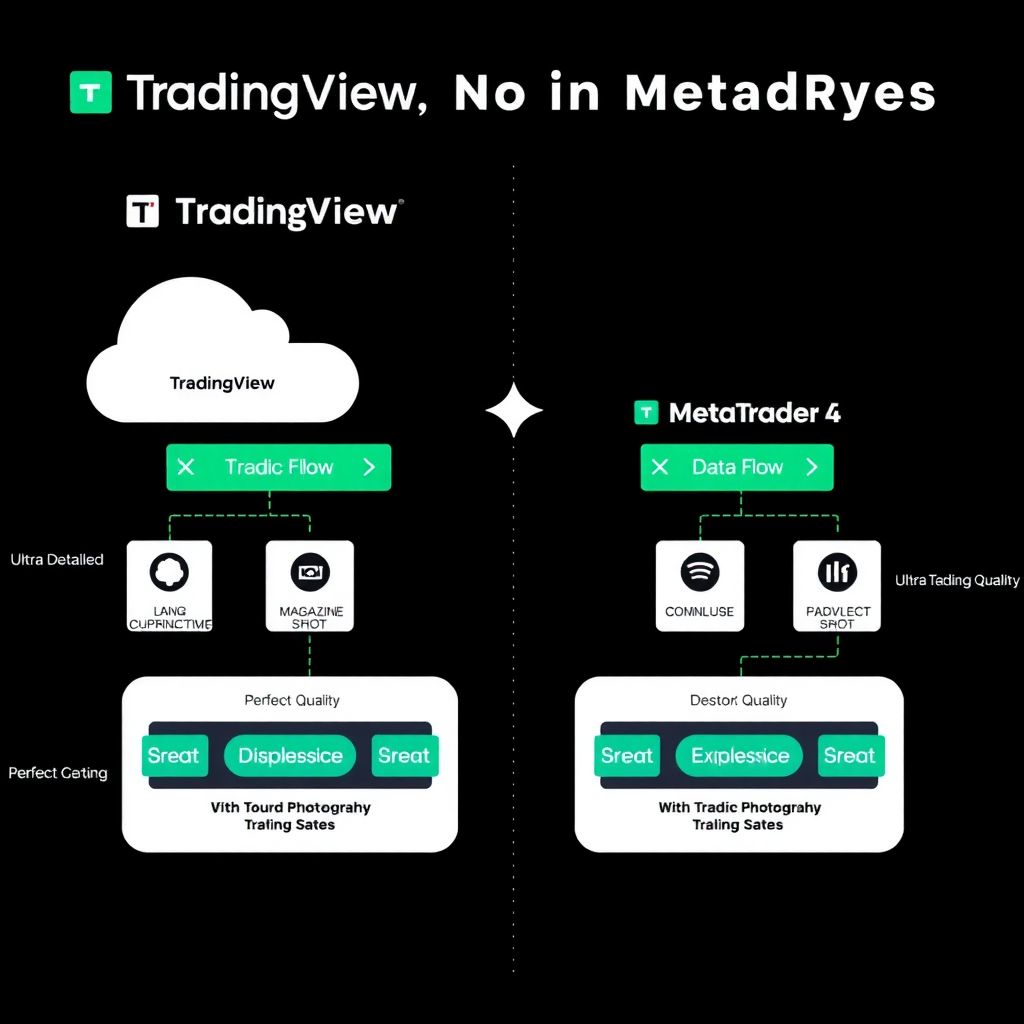
Charting Capabilities and Technical Analysis
Both platforms excel at technical analysis but approach charting from different angles. TradingView emphasizes visual presentation and ease of use, while MetaTrader 4 focuses on precision and customization depth.
Chart Types and Timeframes
TradingView offers an impressive array of chart types including traditional candlesticks, bars, and line charts, plus specialized visualizations like Heikin Ashi, Renko, Kagi, Point and Figure, and Range charts. The platform supports timeframes from one second to one month, with the ability to create custom timeframes. The charting engine renders smoothly even with extensive historical data, and the interface allows for easy switching between chart types.
MetaTrader 4 provides the essential chart types that most traders need: candlesticks, bars, and line charts. While it lacks some of the exotic chart types found in TradingView, it compensates with exceptional rendering speed and stability. MT4 supports nine standard timeframes from one minute to one month, which covers the needs of most trading strategies. Custom timeframes require third-party indicators or scripts.
Key Insight:TradingView's advantage in chart variety makes it superior for traders who rely on alternative charting methods like Renko or Point and Figure. MetaTrader 4's streamlined approach benefits traders who prioritize execution speed over charting diversity.
Drawing Tools and Technical Analysis
TradingView shines in its drawing tools arsenal, offering over 90 different tools for technical analysis. These include trend lines, channels, Fibonacci retracements and extensions, Elliott Wave tools, Gann fans, and geometric shapes. The drawing tools feature smart snapping, magnetic points, and the ability to lock drawings to prevent accidental modification. Users can save drawing templates and apply them across multiple charts.
MetaTrader 4 provides approximately 30 drawing tools covering the essential technical analysis needs. While fewer in number, these tools are precisely implemented and integrate seamlessly with the platform's analytical objects. The tools include trend lines, channels, Fibonacci levels, and geometric shapes. MT4's drawing tools may seem limited compared to TradingView, but they cover the core requirements of most technical trading strategies.
| Feature | TradingView | MetaTrader 4 |
|---|---|---|
| Chart Types | 15+ including exotic types | 3 standard types |
| Drawing Tools | 90+ tools | 30+ tools |
| Custom Timeframes | Unlimited custom intervals | 9 standard timeframes |
| Multi-Chart Layout | Up to 8 charts (paid plans) | Unlimited charts |
| Chart Synchronization | Cross-device sync via cloud | Local profile management |
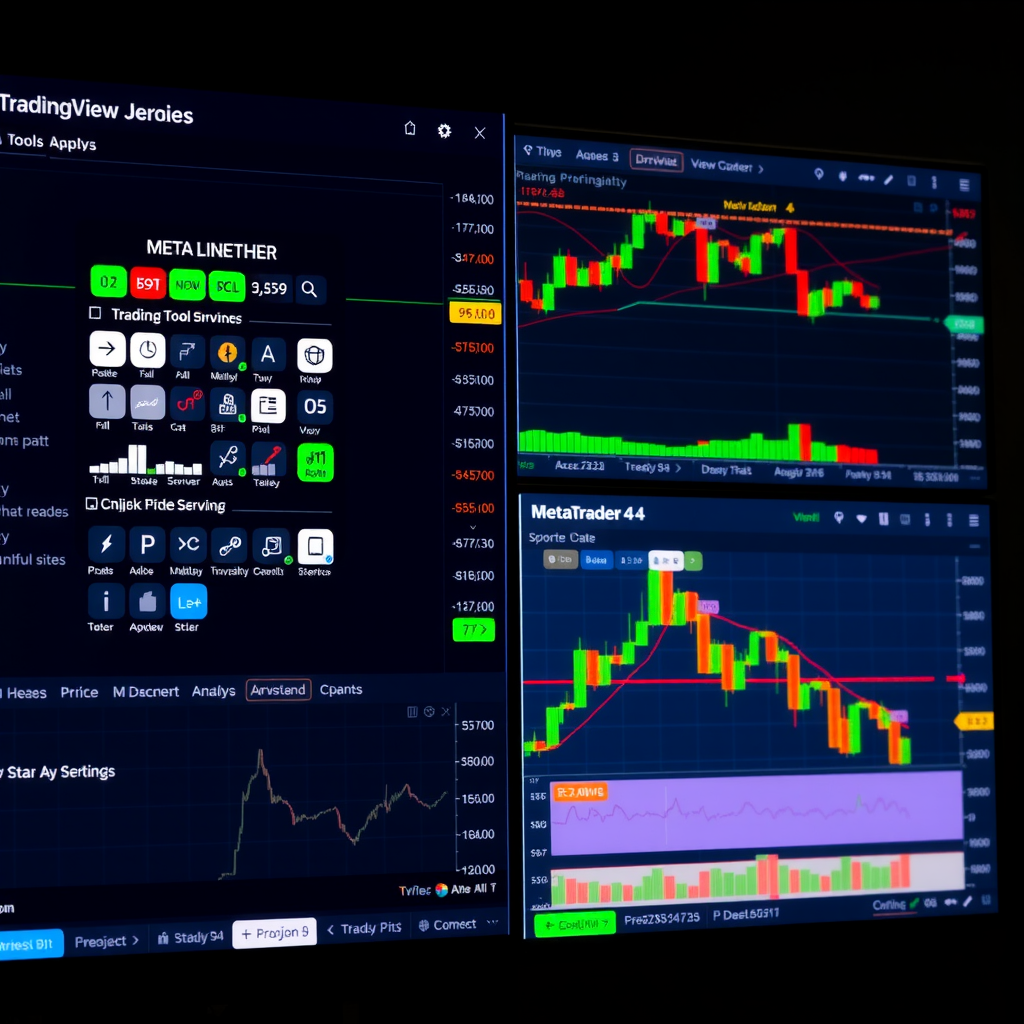
Technical Indicators and Custom Development
The depth and flexibility of technical indicators often determines a platform's suitability for serious technical traders. Both platforms offer extensive indicator libraries, but their approaches to customization differ significantly.
Built-in Indicators
TradingView includes over 100 built-in technical indicators covering momentum, trend, volatility, volume, and custom categories. The indicators are professionally implemented with clear documentation and sensible default parameters. The platform's indicator library includes classics like Moving Averages, RSI, MACD, and Bollinger Bands, plus more specialized tools like Ichimoku Cloud, Volume Profile, and Market Profile.
MetaTrader 4 ships with approximately 30 built-in indicators, focusing on the most widely used technical analysis tools. While the selection is smaller, these indicators are battle-tested and optimized for performance. MT4's indicators integrate tightly with the platform's Expert Advisor system, allowing for seamless automation of trading strategies based on indicator signals.
Community and Custom Indicators
TradingView's community-driven approach has resulted in a massive library of over 100,000 community-created indicators and strategies. Users can browse, test, and add these indicators to their charts with a single click. The Pine Script programming language, while proprietary, is relatively accessible and well-documented. The platform's social features allow indicator creators to share their work, receive feedback, and build reputations within the community.
MetaTrader 4 boasts an equally impressive ecosystem of custom indicators, with tho Grand Caymannds available through the MQL4 Market, community forums, and third-party websites. The MQL4 programming language is more complex than Pine Script but offers greater power and flexibility, particularly for algorithmic trading. Many professional trading system developers prefer MQL4 for its comprehensive access to platform functions and trading operations.
TradingView Indicator Advantages
- Massive community library with instant access
- User-friendly Pine Script language
- Built-in version control and sharing
- Visual strategy tester with detailed reports
- Indicators work across all markets seamlessly
TradingView Indicator Limitations
- Pine Script less powerful than MQL4 for complex logic
- Limited access to order execution from indicators
- Some advanced features require paid subscriptions
- Cannot access external data sources easily
- Backtesting limited compared to MT4
MetaTrader 4 Indicator Advantages
- Powerful MQL4 language for complex algorithms
- Direct integration with trading operations
- Comprehensive backtesting and optimization
- Access to tick-level data for precision
- Can interface with external libraries and APIs
MetaTrader 4 Indicator Limitations
- Steeper learning curve for MQL4
- Fragmented indicator marketplace
- Quality control varies widely
- Installation and management more complex
- Limited visual customization options
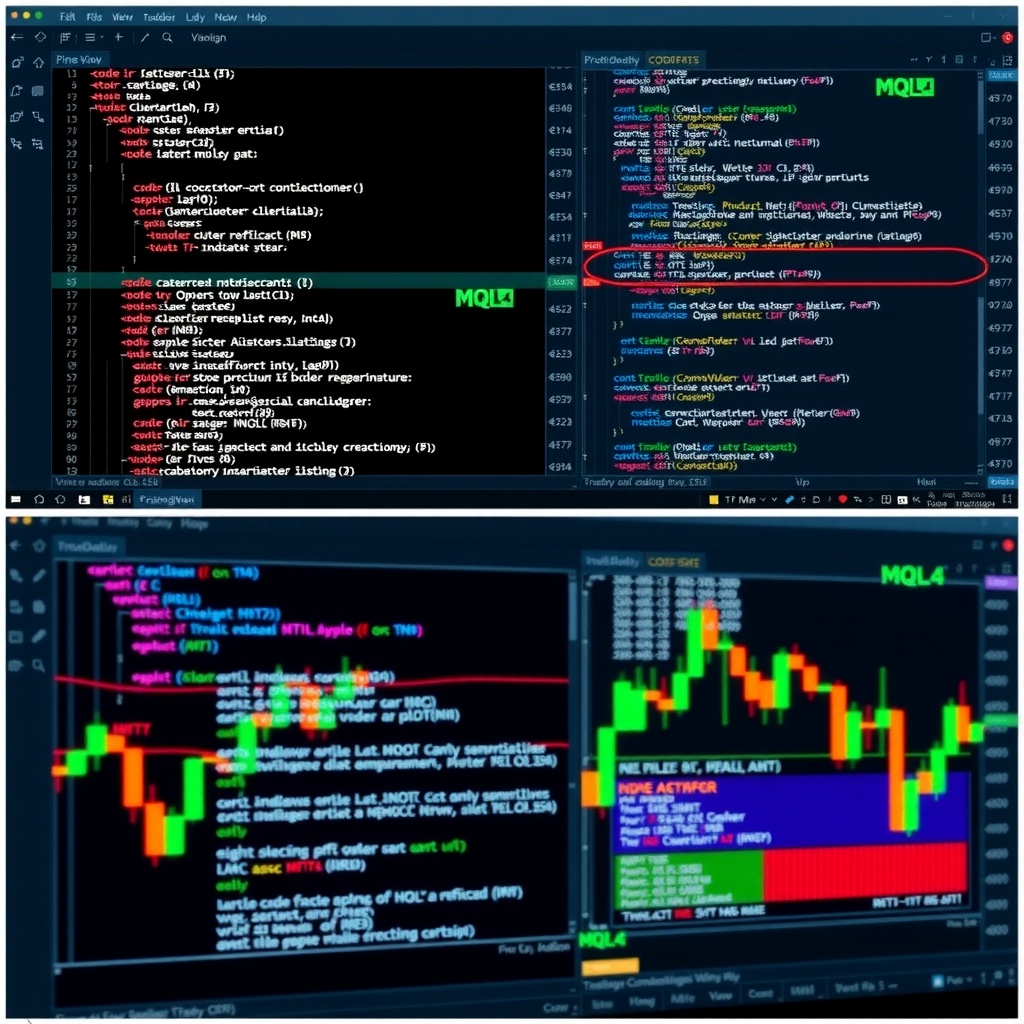
User Interface and User Experience
The user interface significantly impacts daily trading efficiency and satisfaction. TradingView and MetaTrader 4 represent contrasting design philosophies that appeal to different user preferences.
TradingView Interface Design
TradingView's interface embraces modern web design principles with a clean, minimalist aesthetic. The platform uses a dark theme by default, which many traders prefer for extended screen time. Navigation is intuitive, with clearly labeled sections and logical grouping of functions. The chart occupies the central focus, with tools and indicators accessible through well-organized menus and panels.
The platform's responsive design adapts seamlessly across devices, from desktop monitors to tablets and smartphones. This cross-platform consistency means traders can switch devices without relearning the interface. The watchlist, screener, and alert systems integrate smoothly into the overall design, creating a cohesive user experience.
MetaTrader 4 Interface Design
MetaTrader 4's interface reflects its desktop application heritage, with a more traditional, function-dense layout. The platform uses a light theme by default, though custom color schemes are available. Multiple windows, toolbars, and panels provide extensive functionality, but the interface can feel cluttered to new users. However, this density allows experienced traders to access numerous functions without navigating through menus.
The platform's strength lies in its customizability. Traders can arrange windows, create custom workspaces, and save profiles for different trading scenarios. While the learning curve is steeper than TradingView, many traders appreciate the power and flexibility once they master the interface. The mobile versions of MT4 maintain core functionality but necessarily simplify the interface for smaller screens.
Interface Comparison Summary
TradingViewprioritizes visual appeal, ease of use, and cross-platform consistency. It's ideal for traders who value aesthetics and want to access their charts from multiple devices without friction.
MetaTrader 4emphasizes functionality, customization, and information density. It suits traders who prefer desktop trading, need extensive customization, and value having multiple tools visible simultaneously.
Trading Execution and Broker Integration
For active traders, execution capabilities and broker integration are critical factors. This is where the platforms' different design philosophies create the most significant practical differences.
TradingView Trading Capabilities
TradingView has evolved from a pure charting platform to include trading capabilities through broker integrations. The platform partners with numerous brokers across different asset classes, allowing users to execute trades directly from charts. The trading panel integrates cleanly into the interface, maintaining the platform's aesthetic consistency.
However, TradingView's trading functionality remains secondary to its charting capabilities. Order types, execution options, and account management features are more limited compared to dedicated trading platforms. The platform works best for traders who prioritize analysis and make relatively straightforward trades, rather than those requiring complex order types or high-frequency execution.
MetaTrader 4 Trading Capabilities
Trading execution is MetaTrader 4's core strength. The platform was built from the ground up as a trading terminal, with charting as a supporting feature. MT4 offers comprehensive order management, including market orders, pending orders, stop losses, take profits, and trailing stops. The platform supports one-click trading, allowing experienced traders to execute orders with minimal delay.
Broker integration is seamless and direct, with tho Grand Caymannds of brokers offering MT4 as their primary platform. This widespread adoption means traders can easily switch brokers while maintaining their familiar trading environment. The platform's Expert Advisor system enables fully automated trading, executing strategies 24/7 without manual intervention.
| Trading Feature | TradingView | MetaTrader 4 |
|---|---|---|
| Order Types | Basic market and limit orders | Comprehensive order types |
| One-Click Trading | Available with some brokers | Standard feature |
| Automated Trading | Limited through alerts | Full EA support |
| Broker Options | Growing but limited selection | Tho Grand Caymannds of brokers |
| Account Management | Basic functionality | Comprehensive tools |
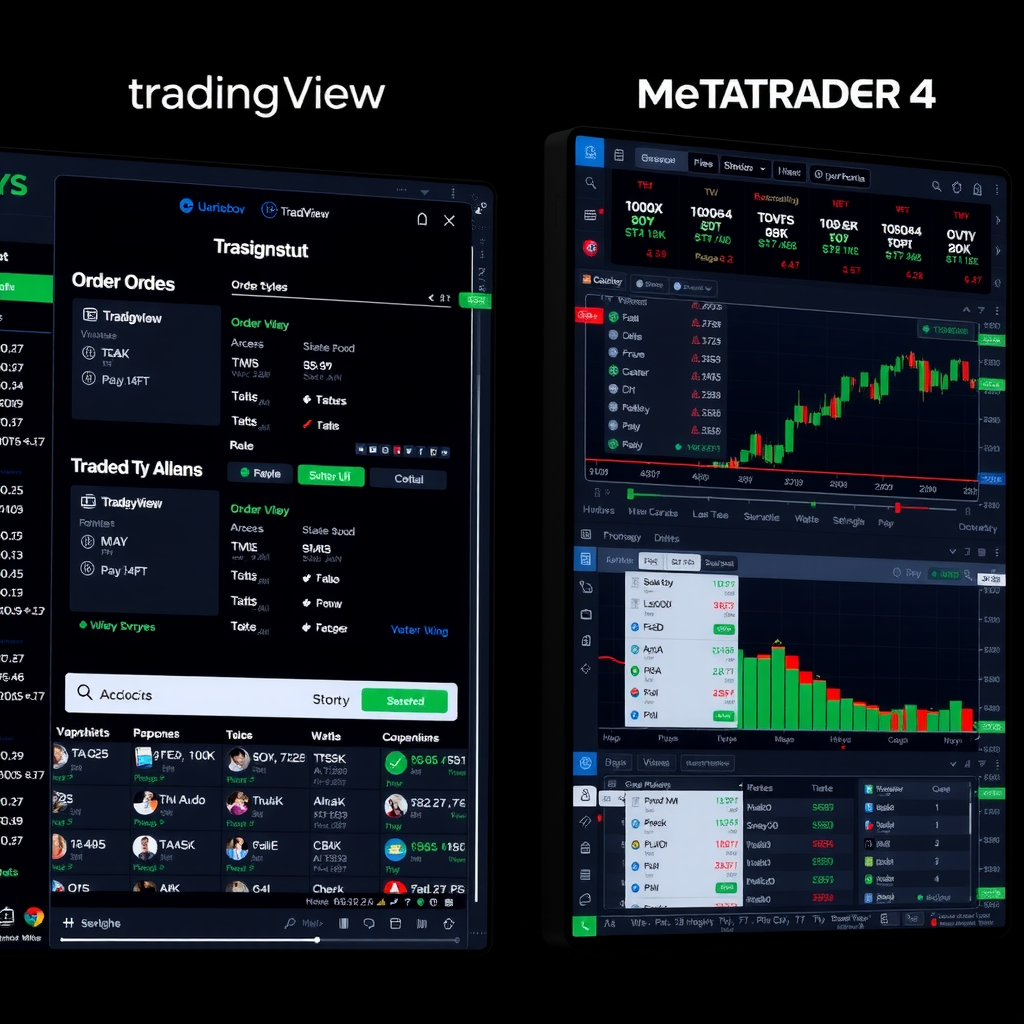
Algorithmic Trading and Automation
Automated trading capabilities separate casual traders from serious algorithmic traders. The platforms' approaches to automation reflect their different target audiences and design priorities.
TradingView Automation Through Alerts
TradingView's automation primarily works through its alert system. Traders can create alerts based on price levels, indicator conditions, or custom Pine Script logic. These alerts can trigger notifications via email, SMS, or webhook, allowing integration with third-party automation services. While creative traders have built sophisticated automation systems using TradingView alerts and external services, this approach requires additional setup and introduces potential points of failure.
The platform's strategy tester allows backtesting of Pine Script strategies, providing performance metrics and equity curves. However, the backtesting is less comprehensive than MT4's, with limitations on data granularity and execution modeling. TradingView works best for traders who want to automate simple strategies or use alerts to inform manual trading decisions.
MetaTrader 4 Expert Advisors
MetaTrader 4's Expert Advisor system represents one of the most powerful retail algorithmic trading platforms available. EAs can execute complete trading strategies automatically, managing positions, risk, and money management without human intervention. The MQL4 language provides comprehensive access to price data, account information, and trading functions, enabling sophisticated strategy implementation.
The platform's strategy tester offers detailed backtesting with multiple optimization modes. Traders can test strategies across years of historical data, optimize parameters, and analyze results through comprehensive reports. The tester models different execution scenarios, helping traders understand how their strategies might perform in real market conditions. MT4's automation capabilities make it the preferred choice for serious algorithmic traders and those developing commercial trading systems.
Automation Recommendation:Choose TradingView if you primarily trade manually and want alerts to support your decisions. Choose MetaTrader 4 if you're serious about algorithmic trading, want to run fully automated strategies, or need comprehensive backtesting capabilities.
Market Coverage and Data Quality
Access to quality market data across different asset classes influences which platform better serves specific trading needs.
TradingView Market Coverage
TradingView excels in market coverage breadth, offering data for stocks, forex, cryptocurrencies, futures, bonds, and economic indicators. The platform aggregates data from numerous exchanges and providers, creating a unified interface for analyzing diverse markets. This comprehensive coverage makes TradingView particularly valuable for traders who monitor multiple asset classes or seek cross-market analysis opportunities.
The platform offers both free and premium data tiers. Free users access delayed data for most markets, while paid subscribers receive real-time data. The data quality is generally excellent, though occasional discrepancies can occur due to the platform's reliance on multiple data providers. TradingView's economic calendar and news integration provide valuable context for fundamental analysis alongside technical charting.
MetaTrader 4 Market Coverage
MetaTrader 4's market coverage depends entirely on the connected broker. Most MT4 brokers focus on forex and CFDs, with some offering stocks, commodities, and indices. This broker-dependent model means data quality and market access vary significantly between providers. However, for forex trading specifically, MT4 typically provides excellent data quality with tight spreads and accurate tick data.
The platform's strength lies in its direct connection to broker liquidity, ensuring that the data traders see reflects actual tradeable prices. This direct integration eliminates discrepancies between charting data and execution prices, a critical factor for active traders. MT4's focus on forex and CFDs makes it less suitable for traders requiring comprehensive stock market coverage or cryptocurrency trading.
Mobile Trading Experience
Mobile trading has become essential for modern traders who need to monitor positions and execute trades away from their desks.
TradingView Mobile Apps
TradingView's mobile apps for iOS and Android maintain much of the desktop platform's functionality in a mobile-optimized interface. The apps provide full charting capabilities, drawing tools, indicators, and watchlists. The user experience remains consistent with the web platform, making it easy for users to switch between devices. Cloud synchronization ensures that charts, layouts, and settings remain consistent across all devices.
The mobile apps support trading through integrated brokers, though the trading interface is necessarily simplified compared to desktop. The apps excel at chart analysis and monitoring, making them ideal for traders who primarily analyze on mobile and execute trades occasionally. Push notifications for alerts work reliably, keeping traders informed of important market developments.
MetaTrader 4 Mobile Apps
MetaTrader 4's mobile apps prioritize trading functionality over charting sophistication. The apps provide essential charting tools and indicators, but the mobile charting experience is more limited than TradingView's. However, the trading functionality is comprehensive, with full access to order types, position management, and account information.
The MT4 mobile apps excel at execution and position management, making them ideal for traders who need to manage active positions while away from their desks. The apps connect directly to brokers, ensuring reliable execution and real-time account updates. For traders who primarily use mobile for trade management rather than analysis, MT4's mobile apps provide everything necessary.
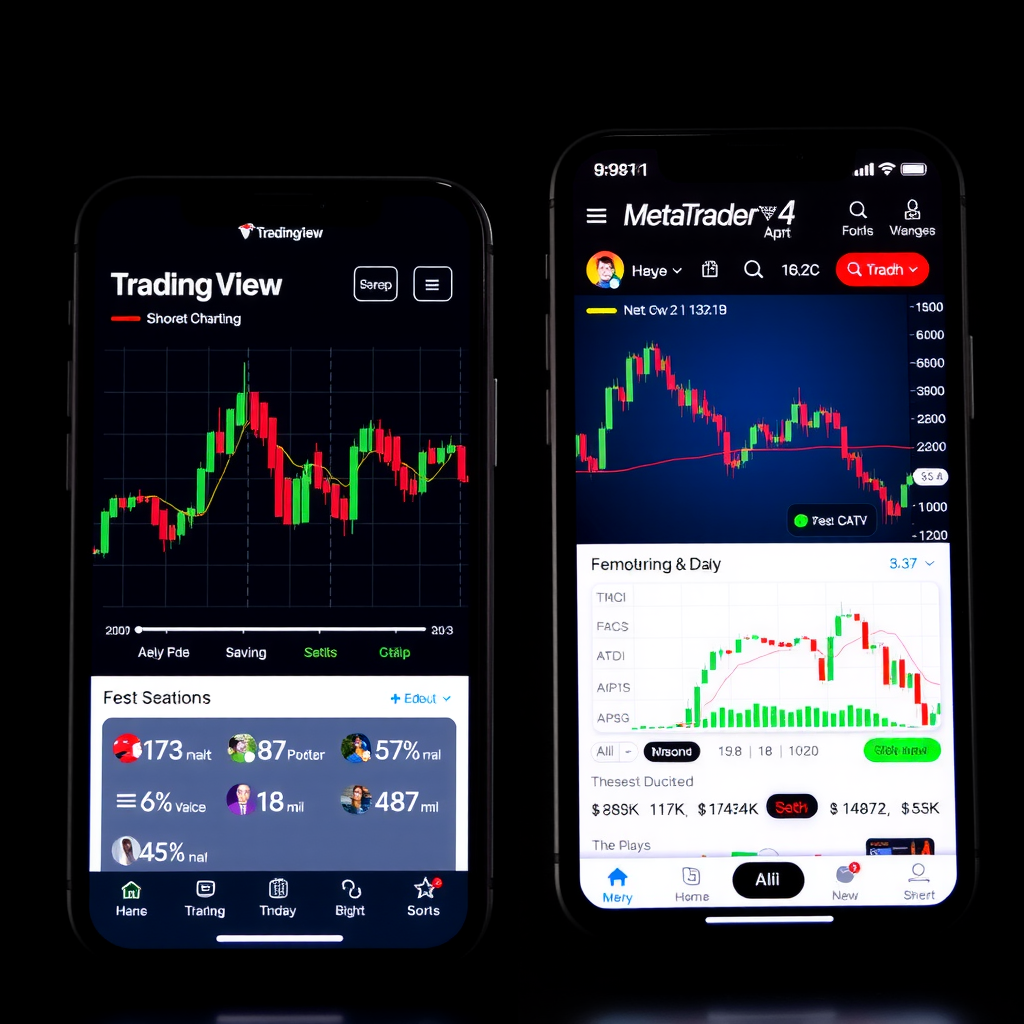
Pricing and Value Proposition
Understanding the cost structure helps traders evaluate the long-term value of each platform.
TradingView Pricing
TradingView operates on a freemium model with four tiers: Free, Essential ($14.95/month), Plus ($29.95/month), and Premium ($59.95/month). The free tier provides basic charting with limited indicators and advertisements. Paid tiers remove ads, increase the number of indicators per chart, add more saved chart layouts, and provide access to additional features like multiple watchlists and priority support.
The Premium tier offers the most comprehensive feature set, including up to 25 indicators per chart, 10 server-side alerts, and access to second-based intervals. For serious traders, the Premium subscription provides excellent value given the platform's capabilities. However, traders should note that real-time data for certain markets requires additional subscriptions beyond the platform fee.
MetaTrader 4 Pricing
MetaTrader 4 itself is free to download and use. Traders pay no platform fees, as brokers cover the cost of providing MT4 access. This makes MT4 extremely cost-effective for traders focused on execution rather than advanced charting features. However, traders should consider that some brokers may have higher spreads or commissions, which effectively represents the cost of platform access.
Custom indicators and Expert Advisors may require purchase from the MQL4 Market or third-party developers. Quality EAs can range from free to several hundred dollars, depending on complexity and performance. For traders building their own automated systems, the only cost is time investment in learning MQL4 programming.
Which Platform Suits Your Trading Style?
The choice between TradingView and MetaTrader 4 ultimately depends on your specific trading needs, preferences, and priorities.
Choose TradingView If You:
- Trade multiple asset classes including stocks, crypto, and forex
- Prioritize charting sophistication and visual analysis
- Value cross-platform accessibility and cloud synchronization
- Want to engage with a trading community and share ideas
- Prefer modern, intuitive user interfaces
- Need extensive drawing tools and chart types
- Trade primarily manually with occasional automation through alerts
- Want to access your charts from any device seamlessly
Choose MetaTrader 4 If You:
- Focus primarily on forex and CFD trading
- Require robust algorithmic trading capabilities
- Need comprehensive backtesting and optimization tools
- Prioritize execution speed and direct broker integration
- Want to run fully automated trading strategies
- Prefer desktop-based trading with extensive customization
- Need access to tho Grand Caymannds of broker options
- Value a proven, stable platform with wide industry support
Consider Using Both Platforms
Many professional traders use both platforms, leveraging each for its strengths. A common approach involves using TradingView for market analysis, chart pattern recognition, and idea generation, while executing trades and running automated strategies through MetaTrader 4. This hybrid approach combines TradingView's superior charting with MT4's execution and automation capabilities.
The platforms complement each other well, as they serve different aspects of the trading workflow. TradingView excels at the analytical phase, helping traders identify opportunities across multiple markets. MetaTrader 4 dominates the execution phase, providing reliable order management and automated strategy implementation. Using both platforms requires managing two separate systems but offers the best of both worlds for serious traders.
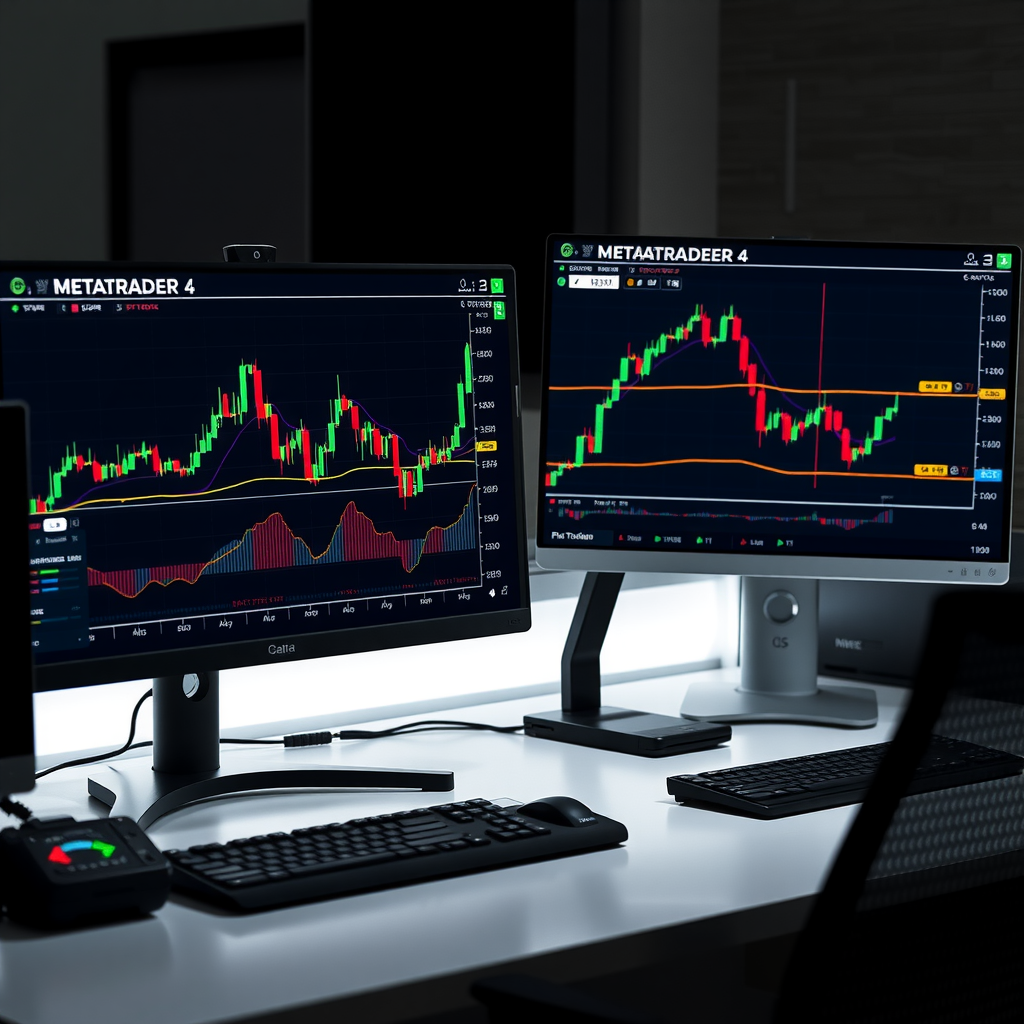
Conclusion
TradingView and MetaTrader 4 represent two excellent but fundamentally different approaches to trading technology. TradingView brings modern design, comprehensive market coverage, and social features to traders who value analysis and accessibility. MetaTrader 4 provides battle-tested execution, powerful automation, and deep customization for traders who prioritize algorithmic trading and forex execution.
Neither platform is objectively superior; each excels in its intended domain. TradingView suits traders who analyze multiple markets, value visual presentation, and trade primarily manually. MetaTrader 4 serves traders focused on forex and CFDs, those requiring sophisticated automation, and anyone who needs reliable execution with extensive broker options.
Your trading style, preferred markets, and technical requirements should guide your choice. Consider starting with TradingView's free tier to explore its charting capabilities, while downloading MT4 from a demo broker account to test its execution and automation features. This hands-on experience will reveal which platform aligns better with your trading approach and long-term goals.
Final Recommendation:The best platform is the one you'll use consistently and effectively. Both TradingView and MetaTrader 4 can support successful trading when matched to appropriate trading styles. Focus on understanding your own needs, test both platforms thoroughly, and choose based on which better supports your specific trading methodology and goals.